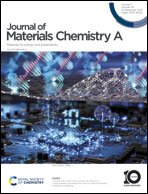Metal-free B4@g-C3N4: a potential electrocatalyst for highly selective and efficient conversion of CO to ethanol†
Abstract
Metal-free catalytic conversion of CO2 is expected to achieve carbon neutrality. However, non-metallic catalytic sites for highly selective and efficient conversion of CO2 to ethanol are challenging. Here, a metal-free catalyst (B4@g-C3N4) has been reported for the first time for the efficient reduction of CO to ethanol. Utilizing electron “accept-donation” analysis, we show that the binding of tri-coordinated B atoms to CO is very mild compared to metal sites and bi-coordinated B atoms. The B4@g-C3N4 catalyst effectively reduced the free energy barrier for direct dimerization of CO to 0.18 eV. The limiting voltage in the entire reduction of CO to CH3HC2OH is −0.19 V, which is better than that of other catalysts, including four-atom metal clusters Cu4–C5N2H2 (−0.50 V) and Cu2Zn2–C5N2H2 (−0.46 V) just proposed (J. Am. Chem. Soc. 2023, 145, 7030–7039). The metal-free electrocatalyst has an absolute selectivity advantage since the molar ratio of the C2 product CH3CH2OH to the C1 product CH4 is 2.55 × 105 : 1. Moreover, due to its extremely high stability, the catalyst designed in this paper holds great promise for synthesis. The above analysis shows that the B4@g-C3N4 catalyst constructed under the new concept proposed by us can achieve the goal of electrocatalytic CO reduction to ethanol. Our work reports the first metal-free electrocatalyst to date for the reduction of CO to ethanol, providing a theoretical basis for promoting the achievement of sustainable carbon neutrality goals.

- This article is part of the themed collection: #MyFirstJMCA


 Please wait while we load your content...
Please wait while we load your content...